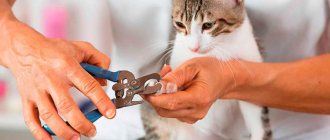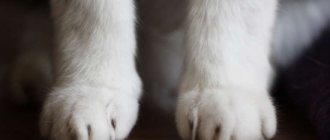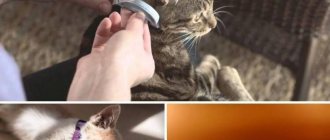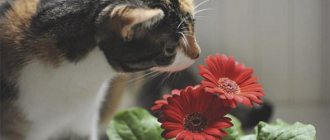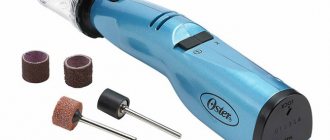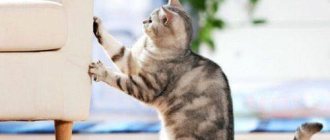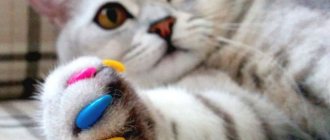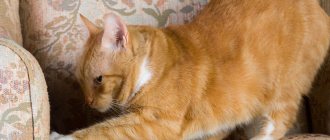Due to their natural instincts, domestic cats regularly sharpen their sharp claws on various objects in the house. Furniture with soft surfaces is most often affected. Some owners who want to eliminate this habit from their animals decide to undergo a special operation that involves declawing their cats. This procedure is also called “soft paws” and “onychectomy.”
Surgical removal can be performed at a veterinary clinic. But should you declaw your cat? To make the right decision, you need to study the benefits of this procedure, as well as all the possible risks and consequences for the animal. It would also be a good idea to seek professional advice from an experienced veterinarian. In our article we will talk in detail about this topic and try to find out how safe onychectomy is for pets.
Declaw removal - onychectomy: pros and cons
Onychectomy is a surgical procedure that involves carefully removing the upper phalanges on the animal’s paws, followed by suturing. The wounds are treated with an ointment with an anesthetic effect, and then bandaged.
This intervention is performed under anesthesia. The owner will have to care for the cat for some time after declawing, following all the doctor’s orders.
Onychectomy is performed for medical reasons:
- damage to the claw phalanx with risks of finger amputation;
- advanced fungal diseases of the claws;
- ingrown claw;
- uncontrollable aggression in an animal.
There are no other indications for this intervention. But despite this, many owners deprive cats of natural protection and many important skills necessary to exist in the environment, solely at their own request.
Of course, if the cat does not go outside, such an operation will not make him particularly damaged. But we still recommend that you carefully consider this idea and decide to perform onychecotomy, correctly weighing all the pros and cons.
Positive influence
Is it possible to call the procedure for declawing cats useful, bringing positive changes to the life of a pet? Of course not, except in cases where the operation is performed purely for medical reasons.
The benefit of a surgical procedure called onychectomy is only to preserve the furniture in the house. The owner will protect his property from damage, but at the same time cause serious mental trauma and physical damage to his furry friend.
Bad influence
Negative aspects are observed already in the first day after the procedure. Poor health, lack of appetite, inability to move independently - these are not all the trials that befell the operated animal.
After a while, the wounds will heal, the cat will gradually begin to come to its senses, an appetite will appear and the ability to move independently, but it will never be able to become the same again. Essentially, your cat will be disabled for life. This is all due to the consequences of onychectomy, which we will now talk about.
Consequences: physical, psychological
Radical declawing operations on domestic cats often have very serious consequences:
- The cat is suffering from excruciating pain.
- Long-term rehabilitation recovery.
- Greater risk of wound infection and prolonged bleeding.
- Impaired gait and grace. The cat has to step on its entire foot, and noticeable lameness appears. But, first, the animal will have to learn to walk again for a long time, which will also create many psychological problems.
- Due to pain and unfamiliarity, the cat becomes inactive, which negatively affects the health of its internal organs. Doctors note that many cats quickly develop diseases of the liver, lungs, stomach and other vital organs after onychecotomy.
- Risks of developing an inflammatory process, which will require a new operation, which may result in severe bleeding, which can be fatal.
- Due to improper gait, which creates increased stress on the spine, the cat may develop diseases of the musculoskeletal system.
- Decreased immunity, susceptibility to various diseases.
- Due to large blood loss after surgery, the cat may die.
What is “onychaetcomia”?
Onychectomy or soft paw surgery is an increasingly popular procedure, along with sterilization, as an alternative to conventional nail trimming for cats.
During onychectomy, the animal is completely deprived of its claws.
This surgery is performed by a veterinarian under general anesthesia. The doctor amputates the end whole phalanx of the fingers along with the claws. The procedure can be carried out through:
– removal of the nail plate with a scalpel and scissors;
– declawing using laser surgery;
The procedure is carried out under the supervision of a specialist
The operation is performed in a clinic, but there is also a home visit. In order to minimize pain, the animal is injected with an anesthetic, and additional medication may be given orally. The rehabilitation period can take a week and during this time the animal needs careful care.
At what age can onychectomy be performed?
Radical declawing surgery is performed on cats at any age. The most optimal time is from 6 months to a year. Previously, the veterinarian sends the animal for tests and examinations to check the health of the cardiovascular system. This will allow us to determine the risks to the animal’s life after general anesthesia is administered.
Based on the results of the examination, the veterinarian determines exactly when such a procedure can be performed and prescribes a specific time. If problems with the kitten’s health are detected, the specialist will recommend that the owner refrain from radical intervention so as not to risk the life of the pet.
Declawing surgery is performed in specialized veterinary clinics. Some owners negotiate with an experienced doctor to perform an onychectomy at home for a certain fee, believing that the cat will more easily tolerate this intervention within its own walls.
Consequences of deletion
After the operation, the following consequences may appear:
soft tissues after such an injury on the paws become inflamed, which is fraught with the onset of a necrotic process;
Losing a large amount of blood during the declawing procedure complicates the healing process;
impaired coordination of movements;
difficulties associated with recovery from anesthesia.
Before the operation, consult a doctor at the clinic and identify the presence of serious medical indications: sometimes the cat actually needs to have 1-2 claws removed. In any case, first assess all the risks, and then begin the procedure.
How much does declawing cost for cats?
So, if you are already seriously thinking about carrying out an operation called “soft paws”, you will, of course, be interested in the question - how much does such a procedure cost in Russia?
The cost of onychectomy is ambiguous and depends on the location and level of the veterinary clinic chosen for this procedure. In Moscow and the Moscow region, the price varies between 3000-5000 rubles. In other regions of the country, such intervention can be carried out at a more affordable price (average cost - from 1000 rubles).
Alternative Methods
Problems with an animal’s claws are not always worth solving in such a radical way as onychectomy. After all, you need to take into account all possible consequences and complications for the health and vitality of your pet. There are many ways to wean a cat from damaging furniture, while at the same time instilling in him a good attitude towards household members.
Here are some alternative methods to deletion:
purchasing a scratching post often completely eliminates the problem of sharpening claws on furniture. It is quite possible to make such an interesting object with your own hands, the main thing is that you need to install the scratching post as soon as possible;
The use of special silicone claw attachments allows you to protect both furniture and human skin from scratches. The pads must be replaced monthly; the animal gets used to them quickly. The cat will not stop scratching the furniture, but there will be no traces left from such actions;
Regular claw trimming can be a complete alternative to surgery. It is better to cut off part of the claw than to completely remove part of the phalanx and put your pet in danger;
You can start training and wean your pet from damaging furniture. To do this, you will need to study tips for raising domestic cats. However, this is a great option that will improve the character of the pussy and allow her to feel comfortable around the household.
You should not rush into such a serious matter as an operation, because without special need you can ruin your pet’s life and harm its health.
Source
Caring for your cat after the procedure
After onychectomy, the cat must be provided with comprehensive care, strictly following all the instructions of the treating veterinarian.
After the operation, the animal’s paws are bandaged, and a special collar is put on the neck. On the first day, the cat leaves after anesthesia; the owner should not leave it unattended. After anesthesia, the pet’s condition will be insane, so there is no need to place the cat on high-lying pieces of furniture. It is better to lay a soft mat on the floor, which will eliminate the risk of falling and injury.
Enhanced care will be required in the first week after radical surgery. To eliminate pain syndromes and speed up recovery, the doctor will prescribe a complex of drug therapy.
What the owner of the operated animal will need to do:
- regularly change bandages and treat wounds with special products prescribed by a veterinarian;
- make sure that the cat does not remove the protective collar, without which it can chew bandages and stitches, which is fraught with quite serious consequences;
- the pet will probably have to receive painkilling injections (as recommended by the doctor);
- Antibacterial therapy is also indispensable;
- every 3-4 days the cat needs to be shown to the veterinarian;
- If bleeding or other adverse effects occur, the pet should be taken to the clinic where the operation was performed as soon as possible.
The rehabilitation period lasts for 3-4 weeks, and sometimes longer. All this time, the owner needs to be extremely attentive to his furry friend.
Why do cats scratch furniture?
Cats are known to be carnivores, so this behavior is completely normal for them, they are simply trying to keep such a vital body part in good condition. If the cat does not do this in time, then the new growing claws will not be able to replace the old ones for a long time, and the animal will feel pain and discomfort because of this.
© shutterstock
Another reason is marking the territory, so the animal tries to show everyone that this place is already occupied. They have special glands on their paws that leave traces with a specific odor. In such situations, the owners begin to think about how to make sure that the furnishings of the house remain intact, but the pet does not lose its fun.
Reviews from owners and veterinarians
Before you decide to have a cat declawing operation, we recommend that you read reviews from veterinarians about this procedure:
- most doctors consider this intervention, performed solely at the request of the cat owner, and not for medical reasons, to be inappropriate and even mocking;
- a procedure that is cruel to an animal often causes many serious consequences, so many experienced doctors consider such risks to be completely unjustified;
- many veterinarians fundamentally refuse to perform onychectomy in the absence of medical indications;
- in European countries, onychectomy is officially prohibited;
- Few doctors approve of such an intervention, but still agree to remove the claws of the unfortunate animal, doomed to a painful existence for the rest of its days.
Even if your cat scratches your baby and furniture in the house, there are many other alternative methods to combat this habit. If you cannot do without surgery, doctors in modern clinics can offer a more loyal procedure - laser removal. After such an intervention, the risks of complications are reduced.
Well, now let's get acquainted with the opinion of the cat owners themselves, who once decided to have an onychectomy.
Positive feedback from the owners:
- there are no scratched walls or tattered furniture in the house;
- Children can safely play with the cat without fear of harm.
Negative reviews from owners:
- a rather long and complex healing process for paws;
- It’s painful to watch an animal suffer;
- the cat begins to go to the toilet in the wrong places;
- leaving your pet alone is already scary, because now she has become defenseless and can easily be injured by any wrong movement;
- the cat's behavior has changed for the worse;
- You can’t let him go outside for a walk;
- After declawing, the cat began to limp and health problems appeared.
Why do cats scratch furniture?
Cats are known to be carnivores, so this behavior is completely normal for them, they are simply trying to keep such a vital body part in good condition. If the cat does not do this in time, then the new growing claws will not be able to replace the old ones for a long time, and the animal will feel pain and discomfort because of this.
© shutterstock
Another reason is marking the territory, so the animal tries to show everyone that this place is already occupied. They have special glands on their paws that leave traces with a specific odor. In such situations, the owners begin to think about how to make sure that the furnishings of the house remain intact, but the pet does not lose its fun.
Is it possible to remove claws at all?
Based on the above facts, we can conclude that such a procedure can be carried out at the discretion of the animal owner, but is it worth risking the health and life of your tailed friend, or is it still possible to find an alternative solution to the problem of scratching furniture and people?
It’s quite possible to stop a cat from damaging furniture and scratching children while playing! There are several effective ways to help you raise an obedient cat without the bad habit of scratching:
- Buy a special accessory - a scratching post and teach your animal to sharpen its claws on this very convenient device! In this simple way you will save expensive furniture in the house and will not deprive your furry pet of its protective claws.
- Be sure to trim your cat's claws as they grow, using a special device - a nail clipper. If you find it difficult to cope with this procedure on your own, seek help from your veterinarian. Clinics perform professional nail trimming for very affordable prices.
- A cat repellent spray will help stop your cat from scratching furniture in a specific place. It has a very unpleasant odor for the animal. You can buy this product at a pet store or veterinary pharmacy.
- To prevent your cat from scratching your children, teach them to play with the animal without using physical force. As a rule, cats do not scratch without a reason; this gesture is performed solely for the purpose of self-defense.
- Special claw covers that visually resemble a nice manicure work quite effectively. Such devices will prevent your cat from scratching walls, furniture and other objects in the house. You can buy miracle pads for sharp claws at a pet store.
It doesn’t matter what kind of cat lives in your house - a British cat, a Scottish cat or an ordinary yard cat, Murka, she is a living creature that deserves your attention and care! Do not subject her to excruciating suffering, think it over several times before you decide to undergo declawing surgery!
Be sure to try using alternative methods to eliminate the annoying scratching habit. If it doesn’t help, consult with an experienced veterinarian and only then make the right decision, which will determine the future fate of your pet!
What if there is a replacement for this method?
It should be noted that such an operation is a radical method and not many people ultimately decide to have their kittens declawed. In addition, animal rights activists actively oppose the use of such inhumane methods. But are there other ways to stop a kitten from ruining everything around with its claws?
Nature dictates that the kitten and subsequently the adult must grind down the claw plate. This instinct cannot be eradicated. Therefore, you need to try to find the possibility of using some measures that will protect the furniture and the owner’s nerves .
- Buy a scratching post. A kitten can be trained to sharpen its claws in a certain place. In addition, their choice is very large and it will not be difficult to choose exactly the one that you will like and your kitten will appreciate.
- Trim your nails regularly. You can do this either yourself or at a veterinary clinic. This type of trimming is an excellent alternative to surgery. Just be careful not to damage the capillaries.
- Use products to attract the kitten to a place where claw sharpening is allowed. Such products are most often produced in the form of a spray and are sold in veterinary pharmacies. People do not smell the spray, but animals are attracted to it. There are other means that, on the contrary, repel the kitten. They can be used to treat places where sharpening claws is not allowed, such as furniture, wallpaper, etc.
If you are determined to send your pet for surgery, then remember that a kitten is declawed at the age of no earlier than 8 months . And know that having experienced such pain as you subject him to during the long postoperative period, he may forever stop trusting his owner. Some even begin to periodically cause mischief and harm. Kittens, having experienced such stress, can become angrier and use their teeth for protection, and this is no less dangerous a weapon than their claws.
Source
Postoperative care
Immediately after removing an ingrown nail, your veterinarian may prescribe antibiotics. They should be taken immediately to avoid the inflammatory process. Additionally, it is recommended to give your pet a complex of minerals and vitamins. In order for injured tissue to quickly recover and heal, immunomodulators are prescribed.
To avoid getting an infection in your foot, wash your floors more often. The room where the pet lives must be clean. Walking and active games are temporarily contraindicated for cats. It is necessary to keep the paw at rest until it has fully recovered.
